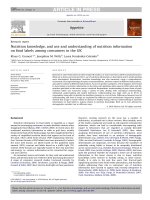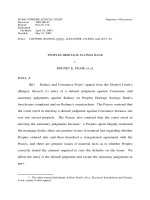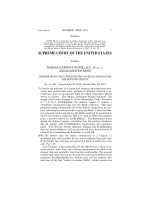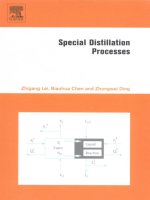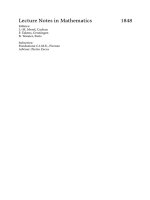GL6 knight et al
Bạn đang xem bản rút gọn của tài liệu. Xem và tải ngay bản đầy đủ của tài liệu tại đây (222.76 KB, 28 trang )
Chasing the Grey
Evidence:
A Standardised
Systematic Literature
Review Approach
Dr. Padam Simkhada
Dr Jane Knight
Department of Public
Health
University of Aberdeen
Acknowledgement
Partners for Research in Emergency
Nutrition
PREN
Garth Reid, Laura Wyness,
Lakshmi Mandava
Department of Public
Health
University of Aberdeen
Overview
•Evidence based public health
•Grey literature
•Advantages and disadvantages
of using grey literature
•Some challenges
•The way forwards
•Conclusions
What is Evidence Based
Public Health
•Evidence based public health as a
public health endeavour in which
there is an informed, explicit, and
judicious use of evidence that has
been derived from any of a variety
of science and social science
research and evaluation methods.
– Sacket et al 1996 BMJ 312 71-72
Evidence Based Public
Health
• The definitions highlights two aspects
of evidence based public health
– The use of a multiple methodologies
evidence to inform public health
decision; publication bias
– An emphasis on clear reasoning in
the process of appraising and
interpreting evidence for policy and
implementation
Getting the evidence from
Systematic Literature
Review
• Searching for and locating
appropriate literature
• Critically examining the results and
extracting relevant detail
• Synthesizing and writing the
review and produce a evidence
Evidence beyond RCTs
Other
factors
Geographic
al context
Culture
Socil and
political
context
Previous
perceptions
Evidence beyond RCTs
Culture
Other factors
Evidence
Geographical
context
Social and political
context
Previous perception
Evidence to Policy
Social
and
politica
l conte
xt
Geogra
phical
contex
t
Evidence
us
o
i
v
s
Pre
n
o
i
t
ep
perc
ure
t
l
u
C
Policy
Action
or
Practice
Levels of evidence &
volume of grey literature
Systematic reviews
and meta-analyses
RCT
Levels of
evidence
Quasi
experimenta
l
Controlled
observational
Observational studies
without controls
Expert opinion
Volume of
grey
literature
Research Questions
•Management of
childhood
malnutrition in
complex
emergencies
What is a Systematic
Literature Review
•Aim is to reduce
uncertainty by a
rigorous methodology
that is:
– Comprehensive
– Transparent or explicit
– Leads to minimum bias
– Reproducible
Childhood Malnutrition in
Complex emergencies
Initially identified
4802
Title/abstract scanned
Included
173
Full paper scanned
Non grey
12
Definition of grey
literature
“Grey literature is defined
as any literature that is not
published in academic peer
reviewed journals and
available through indexed
databases for review”
Search for grey literature
•Call for information
•Personal and institutional
contact
•World-wide web search
Challenges for a
representative search
• Problems with call for information
– personal interest/limitations
• Problems with personal and
institutional contact
– Staffs changes on NGOs
• World-wide web
– large number and difficulties in
filter
Challenges for a
representative search
•Difficult to control
bibliographically
•Grey database
– not widely available
– institutional subscribe
– eg SIGLE (System for information on Grey Literature in
Europe)
Different type of grey
literature
•Annual reports
•Theses/dissertations
•Conference
abstracts/proceedings
•Working papers
•Evaluation reports
•Facts sheets and others
Searching for
representative literature
•Which
•Which
•Which
•Which
organisations?
key opinions?
databases?
web sites?
Framework for a
representative search
International
International
level
National
Level
Local Level
National
Local
Childhood Malnutrition in
Complex emergencies
Initially identified
4802
***
Title/abstract scanned
Full report
102
Included
173
Full paper scanned
Non grey
12
Grey
8
20
Advantages of including
‘grey’ in a literature
review
•Access to wider variety of
information
•Reduces publication bias
•Contain more local informationimportant for planning
•Contain process informationimportant for policy makers
Advantages of including
‘grey’ in a literature
review
•Reports not published in peer
reviewed journals (e.g. UN, WHO, HTA)
•Access to new research
•World Wide Web (4-6 Billion web
pages)
•Contain valuable and unique
information, which is not found
elsewhere
Searching for
representative literature
1. Systematic review of
published literature
(databases)
2.Basic review of grey
literature (web)
Value of
literature
identified
3. Personal communication
with organisations and
experts identified.
Phase
1
Phase
2
Phase
3
Phase
4
4. Validation of
representaiveness
Literature review
framework
Searching for and
locating appropriate
literature
Critically examining the
results and extracting
relevant details
Synthesising and writing
the review
Published
literature
Standard tools and procedure developed
Process
Grey literature
1. Call for information
2. Personal and institutional
contact
3. World-wide web base
search and grey literature
data base search
1. Assessment of
methodological quality
2. Data extraction
1. Combination with other
evidence
2. Same as peer reviewed
